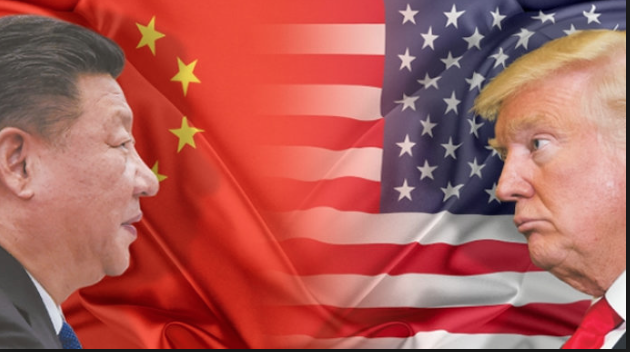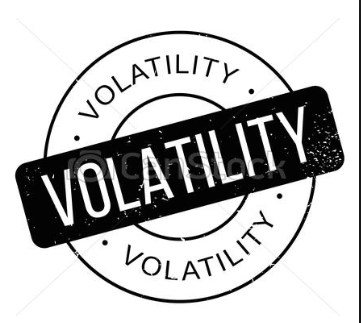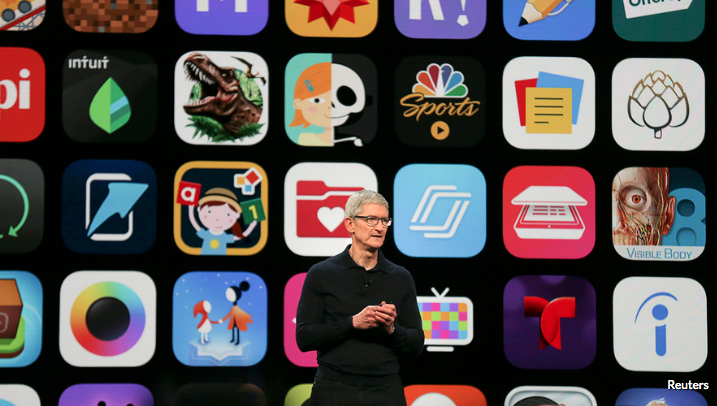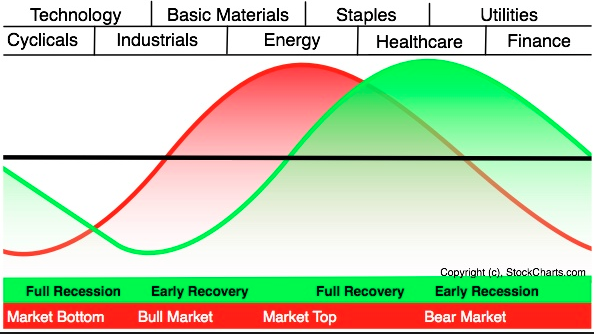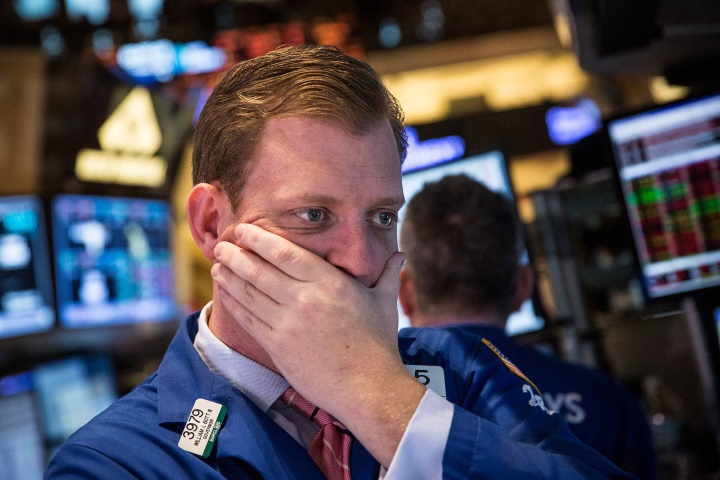But China does not purchase $200 billion worth of goods from the United States. There in lay the problem for China with the latest declaration from President Trump and his call for another $200 billion in tariffs to be enacted against the Asian nation. The news broke late last night that President Trump directed the United States Trade Representatives to identify $200 billion worth of Chinese goods for additional tariffs. The official statement from the President is noted below.
“On Friday, I announced plans for tariffs on $50 billion worth of imports from China. These tariffs are being imposed to encourage China to change the unfair practices identified in the Section 301 action with respect to technology and innovation. They also serve as an initial step toward bringing balance to our trade relationship with China.
However and unfortunately, China has determined that it will raise tariffs on $50 billion worth of United States exports. China apparently has no intention of changing its unfair practices related to the acquisition of American intellectual property and technology. Rather than altering those practices, it is now threatening United States companies, workers, and farmers who have done nothing wrong.
This latest action by China clearly indicates its determination to keep the United States at a permanent and unfair disadvantage, which is reflected in our massive $376 billion trade imbalance in goods. This is unacceptable. Further action must be taken to encourage China to change its unfair practices, open its market to United States goods, and accept a more balanced trade relationship with the United States.
Therefore, today, I directed the United States Trade Representative to identify $200 billion worth of Chinese goods for additional tariffs at a rate of 10 percent. After the legal process is complete, these tariffs will go into effect if China refuses to change its practices, and also if it insists on going forward with the new tariffs that it has recently announced. If China increases its tariffs yet again, we will meet that action by pursuing additional tariffs on another $200 billion of goods. The trade relationship between the United States and China must be much more equitable.
I have an excellent relationship with President Xi, and we will continue working together on many issues. But the United States will no longer be taken advantage of on trade by China and other countries in the world.
We will continue using all available tools to create a better and fairer trading system for all Americans.”
So is this “the trade war” that investors have been fearful of for some time now? It is and it isn’t and here is how that can be a binary truism. Firstly, the escalation of rhetoric is not yet an implementation of the proposed tariffs. Secondly, time is still of the most valuable asset in the tit-for-tat spat between the 2 nations and ahead of a full scale implementation of proposed tariffs. Additionally and as recognized within, China will need to consider other forms of retaliation as the nation simply does not import an equivalent of goods in value for which to respond to the latest escalation.
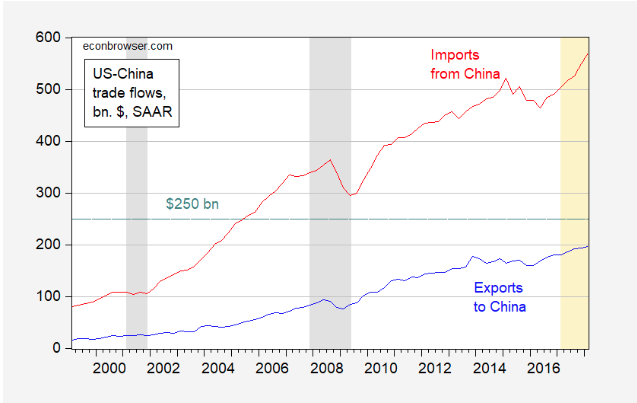
This would mean that some consumer goods (PCs, tablets, phones) would have to be taxed by the U.S., resulting in a more visible increase to consumer prices. In other words, the administration would literally be importing inflation. The following graph identifies the where the U.S. shows large trade deficits and minimal surplus with from its trade with China.
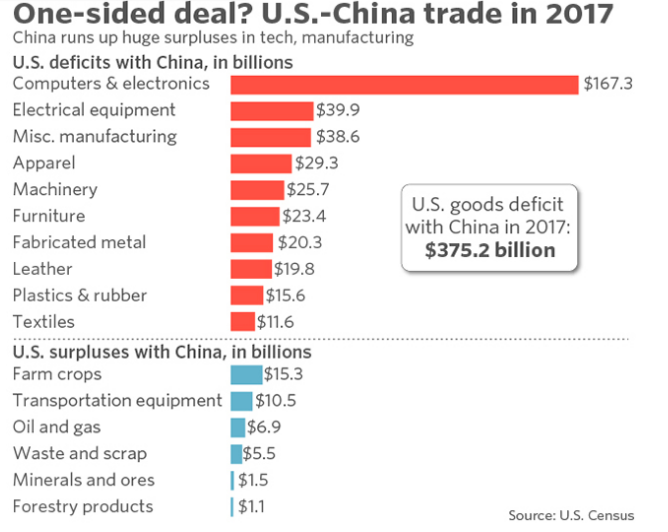
China could implement bans or boycotts on certain U.S. goods. Moreover, China could respond to any deficiencies or shortcomings in its economic activity from the proposed U.S. trade tariffs with economic stimulus. China’s central bank on Tuesday lent 200 billion yuan ($31 billion) to financial institutions via its medium-term lending facility (MLF), highlighting concerns over liquidity and potential economic drag from a trade war with the United States.
Adding yet another layer to trade tensions, the Senate passed legislation on Monday to reinstate a ban on sales of U.S. components to ZTE Group, despite efforts by Trump to spare the Chinese telecommunications company.
Asian equity markets fell sharply on the latest escalation of rhetoric between the world’s largest economies. China and the United States make up roughly 85% of global GDP.
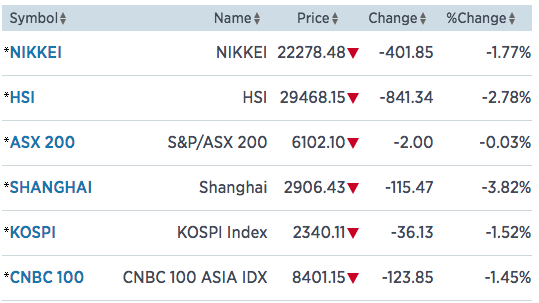
There will likely be no greater news that investors consider today in light of the recent headlines on trade. When it is all said and done, time is of the essence and Finom Group believes negotiations between the U.S. and China will resolve in limited tariff implementation. As such an opportunity is being created whereby the current global equity sell-off finds good companies selling at lesser price-to-earnings multiple. The tough talk of the day will likely serve to weigh on equity prices, but investors whom are flush with cash will be able to acquire good companies with a long-term outlook.
As it pertains to creating a shopping list of stocks or sector ETFs, investors should always consider firstly investing in what they know. From there, broadening a stock-shopping list could also consider U.S. nationals or stocks with limited tariff exposure. Finom Group’s list of potential stocks to acquire looks like the following:
- Facebook (FB)
- Twitter (TWTR)
- Target (TGT)
- Retail Sector Spiders ETF (XRT)
- Financial Sector Spiders ETF (XLF)
- Alphabet (GOOGL)
- Chipotle Mexican Grill (CMG)
- Costco (COST)
- IBuy (IBUY)
With the U.S. equity sell-off, the market is also expressing heightened levels of volatility. Finom Group models its trade and investment alerts from the Golden Capital Portfolio, managed by Seth Golden whom is also Finom Group’s chief market strategist. Back on June 6th, Golden informed the public and subscribers of the reduced exposure to the volatility complex as part of Golden Capital’s holdings.

The current spike in volatility coming from the global equity sell-off may produce yet another opportunity to short volatility at higher levels. The VIX has jumped nearly 20% in Tuesday’s trade to just over 14 percent. It remains to be seen how much more the VIX can rise in the near term, but given the circumstances surrounding volatility, the opportunity appears a justifiable way to recapture iPath S&P 500 VIX Short-Term Futures ETN (VXX) that were previously covered. The current Golden Capital Portfolio exposure to VIX-Exchange Traded Products rests at 16.2% of total portfolio holdings. The Portfolio averages 20% exposure to VIX-ETPs on an annual basis and since 2012. In 2018, the Portfolio’s high exposure mark was 21.7% on April 19th and before gradually reducing exposure as profits were extrapolated since the February VIX event.
On a daily/weekly basis, Finom Group is performing scalp trades with VIX-ETPs and other equity instruments and sending alerts to our subscribers through our private Twitter feed. Yesterday’s trade alert was on shares of SodaStream (SODA). The trade alert was captured in real time and the screen shot below depicts the successful trade.
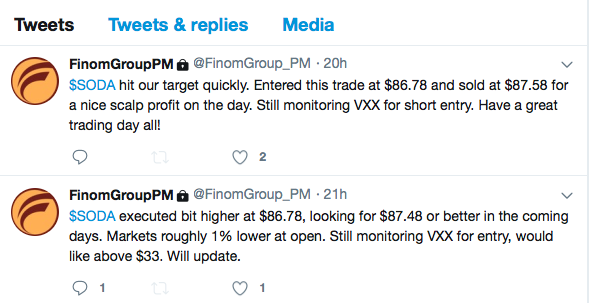
Last week we performed several VXX, successful short trades as indicated in our Friday trade alert below.
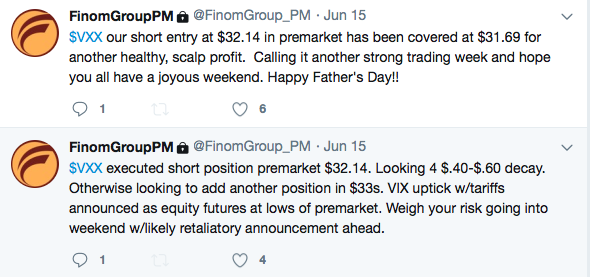
U.S. equity futures are sharply lower, although off the lows of the pre-market session. Given the level of importance paid to the current trade war rhetoric, of all the days to ignore headlines and flow of media, this would not be the day to do so. Finom Group will be updating subscribers on the trades we are making as the day/week progresses. Opportunity awaits!
Tags: COST FB SODA SPY DJIA IWM QQQ SVXY TGT TVIX TWTR UVXY VMAX VXX

